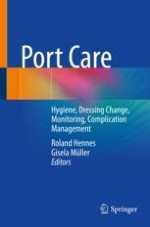Erschienen in:
2022 | OriginalPaper | Buchkapitel
13. Evidence of Port Care
Abstract
Evidence-based statements on port care are a rarity; most recommendations are based on empiricism. The most important measure in port care is compliance with hygiene guidelines. Only suitable special cannulas may be used for puncture. To reduce the risk of thrombosis and infection, blood sampling from the central venous line should be avoided. Ports should be flushed before and after fluid infusion or injection. There is no evidence for the type and amount of flushing solution, but usually only sterile saline is recommended for flushing and saline without added heparin may also be recommended for blocking the port.
Anzeige















